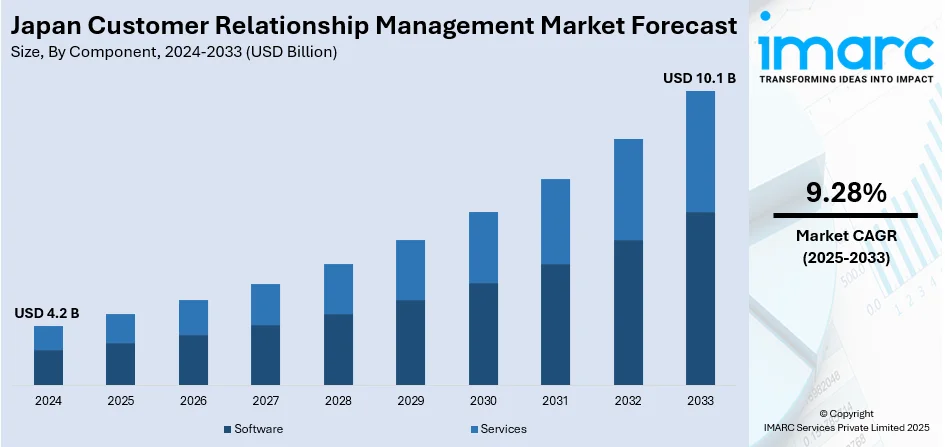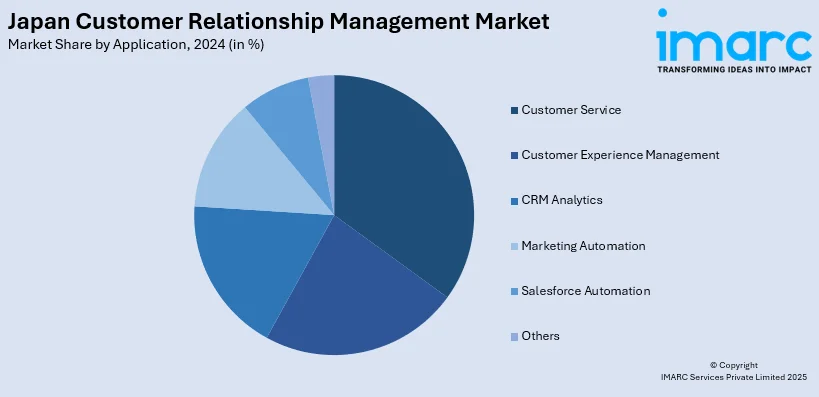
Japan Customer Relationship Management Market Size, Share, Trends and Forecast by Component, Deployment Mode, Organization Size, Application, Industry Vertical, and Region, 2025-2033
Japan Customer Relationship Management Market Overview:
The Japan customer relationship management market size reached USD 4.2 Billion in 2024. Looking forward, IMARC Group expects the market to reach USD 10.1 Billion by 2033, exhibiting a growth rate (CAGR) of 9.28% during 2025-2033. The market is driven by rising demand for integrated, cross-functional platforms and real-time engagement tools. Businesses are adopting CRM systems that support collaboration across departments, enhance customer insights, and align with broader digital transformation strategies for improved operational efficiency and service delivery.
|
Report Attribute
|
Key Statistics
|
|---|---|
|
Base Year
|
2024
|
|
Forecast Years
|
2025-2033
|
|
Historical Years
|
2019-2024
|
| Market Size in 2024 | USD 4.2 Billion |
| Market Forecast in 2033 | USD 10.1 Billion |
| Market Growth Rate 2025-2033 | 9.28% |
Japan Customer Relationship Management Market Trends:
Demand for Unified Team Engagement in CRM
The market is seeing a strong push toward solutions that support unified team engagement. This shift stems from the growing recognition that successful customer relationships involve multiple departments beyond just sales. Companies are increasingly moving to CRM platforms that empower cross-functional teams to work together within a single system. In August 2024, Zoho introduced early access to “Zoho CRM for Everyone,” a major update that allowed teams across departments like marketing, presales, and legal to collaborate within the CRM environment. With features such as Teamspaces and Requests, the platform enabled better internal communication, minimized repetitive handovers, and kept the full customer journey visible to all stakeholders. This change is especially relevant in Japan’s business environment, where interdepartmental coordination is essential for long-term client engagement. Organizations that adopt CRM systems supporting multi-team access are streamlining workflows, improving internal efficiency, and delivering faster, more consistent service. The trend is not only improving internal operations but also enhancing the overall customer experience, as clients now benefit from better-informed and quicker responses. As digital tools become more advanced, this focus on inclusive CRM usage is expected to expand, driving adoption among Japanese firms aiming for operational clarity and stronger customer engagement.

Push for CRM Integration Across Business Functions
The CRM market in Japan is also being shaped by the growing demand for integrated enterprise systems that connect customer engagement with HR and finance operations. Companies are no longer viewing CRM as a standalone tool; instead, they are embedding it within broader digital transformation strategies. This trend is driven by the need to eliminate siloed data and achieve better visibility across departments. In October 2024, Ataway Japan partnered with Workday to offer implementation services for Human Capital Management and Financial Management systems. This partnership allowed Ataway to extend its CRM-linked capabilities, helping businesses align HR insights and financial data with customer strategies. By merging employee, financial, and client information, companies gain a clearer view of customer profitability, workforce performance, and service delivery standards. In Japan’s structured corporate culture, such comprehensive integration supports informed decision-making, standardized service delivery, and faster issue resolution. The ability to analyze operational and customer data in one place helps businesses anticipate needs and personalize interactions at scale. This integrated approach is becoming essential for firms seeking competitive advantage in customer relationships, as it supports agile responses and more efficient internal coordination. The market is expected to lean further into solutions that unify enterprise functions around customer-centric outcomes.
Japan Customer Relationship Management Market Segmentation:
IMARC Group provides an analysis of the key trends in each segment of the market, along with forecasts at the country level for 2025-2033. Our report has categorized the market based on component, deployment mode, organization size, application, and industry vertical.
Component Insights:
- Software
- Services
The report has provided a detailed breakup and analysis of the market based on the component. This includes software and services.
Deployment Mode Insights:
- On-premises
- Cloud-based
A detailed breakup and analysis of the market based on the deployment mode have also been provided in the report. This includes on-premises and cloud-based.
Organization Size Insights:
- Small and Medium-sized Enterprises
- Large Enterprises
A detailed breakup and analysis of the market based on the organization size have also been provided in the report. This includes small and medium-sized enterprises and large enterprises.
Application Insights:

- Customer Service
- Customer Experience Management
- CRM Analytics
- Marketing Automation
- Salesforce Automation
- Others
A detailed breakup and analysis of the market based on the application have also been provided in the report. This includes customer service, customer experience management, CRM analytics, marketing automation, salesforce automation, and others.
Industry Vertical Insights:
- BFSI
- Retail
- Healthcare
- IT and Telecom
- Discrete Manufacturing
- Government and Education
- Others
A detailed breakup and analysis of the market based on the industry vertical have also been provided in the report. This includes BFSI, retail, healthcare, it and telecom, discrete manufacturing, government and education, and others.
Regional Insights:
- Kanto Region
- Kansai/Kinki Region
- Central/ Chubu Region
- Kyushu-Okinawa Region
- Tohoku Region
- Chugoku Region
- Hokkaido Region
- Shikoku Region
The report has also provided a comprehensive analysis of all the major regional markets, which include Kanto Region, Kansai/Kinki Region, Central/ Chubu Region, Kyushu-Okinawa Region, Tohoku Region, Chugoku Region, Hokkaido Region, and Shikoku Region.
Competitive Landscape:
The market research report has also provided a comprehensive analysis of the competitive landscape. Competitive analysis such as market structure, key player positioning, top winning strategies, competitive dashboard, and company evaluation quadrant has been covered in the report. Also, detailed profiles of all major companies have been provided.
Japan Customer Relationship Management Market News:
- January 2025: SAP introduced a loyalty management solution at Retail’s Big Show to enhance CRM strategies for retailers. Integrated with SAP Commerce Cloud and Emarsys, it supported personalized engagement. The development advanced Japan’s CRM industry by promoting data-driven, real-time customer experience optimization.
- January 2025: Volkswagen Group and CARIAD partnered with Capgemini to roll out ONE.CRM, a global Salesforce-based CRM platform. The initiative unified CRM systems across regions, including Japan, enhancing marketing, sales, and service functions, and driving consistent, data-driven customer engagement in the automotive sector.
Japan Customer Relationship Management Market Report Coverage:
| Report Features | Details |
|---|---|
| Base Year of the Analysis | 2024 |
| Historical Period | 2019-2024 |
| Forecast Period | 2025-2033 |
| Units | Billion USD |
| Scope of the Report |
Exploration of Historical Trends and Market Outlook, Industry Catalysts and Challenges, Segment-Wise Historical and Future Market Assessment:
|
| Components Covered | Software, Services |
| Deployment Modes Covered | On-premises, Cloud-based |
| Organization Sizes Covered | Small and Medium-sized Enterprises, Large Enterprises |
| Applications Covered | Customer Service, Customer Experience Management, CRM Analytics, Marketing Automation, Salesforce Automation, Others |
| Industry Verticals Covered | BFSI, Retail, Healthcare, IT and Telecom, Discrete Manufacturing, Government and Education, Others |
| Regions Covered | Kanto Region, Kansai/Kinki Region, Central/ Chubu Region, Kyushu-Okinawa Region, Tohoku Region, Chugoku Region, Hokkaido Region, Shikoku Region |
| Customization Scope | 10% Free Customization |
| Post-Sale Analyst Support | 10-12 Weeks |
| Delivery Format | PDF and Excel through Email (We can also provide the editable version of the report in PPT/Word format on special request) |
Key Questions Answered in This Report:
- How has the Japan customer relationship management market performed so far and how will it perform in the coming years?
- What is the breakup of the Japan customer relationship management market on the basis of component?
- What is the breakup of the Japan customer relationship management market on the basis deployment mode?
- What is the breakup of the Japan customer relationship management market on the basis of organization size?
- What is the breakup of the Japan customer relationship management market on the basis of application?
- What is the breakup of the Japan customer relationship management market on the basis of industry vertical?
- What is the breakup of the Japan customer relationship management on the basis of region?
- What are the various stages in the value chain of the Japan customer relationship management market?
- What are the key driving factors and challenges in the Japan customer relationship management market?
- What is the structure of the Japan customer relationship management market and who are the key players?
- What is the degree of competition in the Japan customer relationship management market?
Key Benefits for Stakeholders:
- IMARC’s industry report offers a comprehensive quantitative analysis of various market segments, historical and current market trends, market forecasts, and dynamics of the Japan customer relationship management market from 2019-2033.
- The research report provides the latest information on the market drivers, challenges, and opportunities in the Japan customer relationship management market.
- Porter's five forces analysis assist stakeholders in assessing the impact of new entrants, competitive rivalry, supplier power, buyer power, and the threat of substitution. It helps stakeholders to analyze the level of competition within the Japan customer relationship management industry and its attractiveness.
- Competitive landscape allows stakeholders to understand their competitive environment and provides an insight into the current positions of key players in the market.
Need more help?
- Speak to our experienced analysts for insights on the current market scenarios.
- Include additional segments and countries to customize the report as per your requirement.
- Gain an unparalleled competitive advantage in your domain by understanding how to utilize the report and positively impacting your operations and revenue.
- For further assistance, please connect with our analysts.
 Request Customization
Request Customization
 Speak to an Analyst
Speak to an Analyst
 Request Brochure
Request Brochure
 Inquire Before Buying
Inquire Before Buying




.webp)




.webp)












